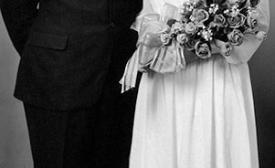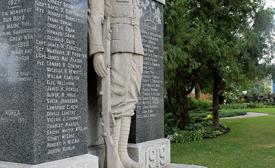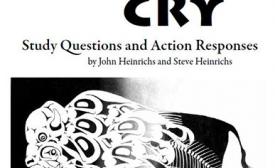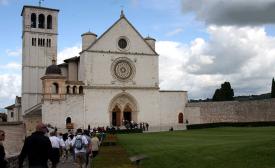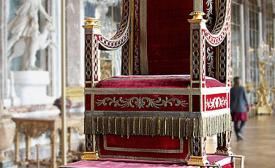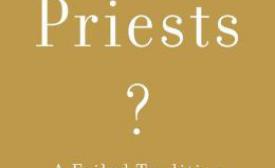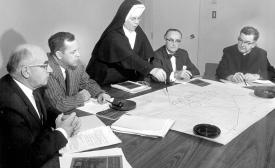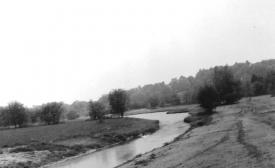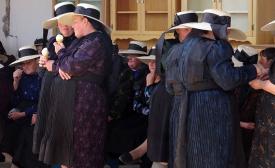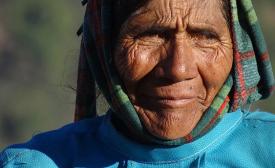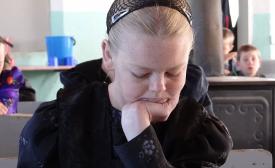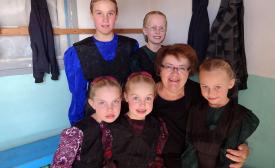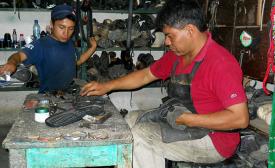Feature
Atonement
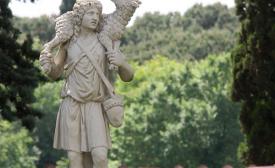
A statue of the Good Shepherd at the St. Callisto Catacombs, Rome. In the early centuries, Jesus was much more likely to be portrayed as the Good Shepherd than as a crucified Messiah.

The Gero Crucifix in the Kölner Dom (Cologne Cathedral, Germany). In the Middle Ages, Jesus’ suffering on the cross came to the fore, shadowing other images of Jesus as Saviour.
In the 1990s, when the Mennonite church in Ontario was deciding whether to add Hymnal: A Worship Book to its pews, a dear (now departed) saint approached me, saying, “I hear that they’ve taken out all the blood songs.” The person wondered if this important part of church heritage and theology was going to be left behind.
For discussion: 'Let nobody judge them'
Uncle Sam goes to jail
Of memories I have of family members, the one about my Uncle Sam’s arrest on April 19, 1944, and his imprisonment, which became legendary in our community, left an indelible mark. Uncle Sam was born in the U.S. and was 18 months old when the family moved to Duchess [Alta.]. He had been baptized into the Mennonite Church and attended regularly.
‘Let nobody judge them’

An Altona, Man., war memorial bears the names of local Mennonites who served and died during the Second World War.
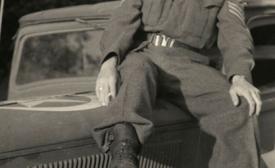
V. Wiebe of B.C.’s Fraser Valley served with the Canadian forces in the Second World War, earning five medals. According to ‘The Mennonite Menace: Real or Imagined, an online report from a University of the Fraser Valley student, 66 of 99 Mennonites in Yarrow, B.C., served in the Canadian military, either in combatant roles or as part of the medical corps.
Of late, many peace-minded Canadians have been decrying the country’s increasing militarization, calling to mind this country’s proud peacekeeping tradition as if it was a defining feature of confederation. Unfortunately, it’s a false memory, as Canada’s peacekeeping forces weren’t formed until 1956. Its military involvements, however, go back nearly to our country’s beginning.
For discussion: Rethinking peace
Mennonite Church Canada Peace Audit: a long procession
The General Council Peace Commission of Mennonite World Conference (MWC) requested a response from Mennonite Church Canada to the question, “How is your church doing in its desire to be a Peace Church?” The two key phrases of this request to our church is, “desire to be” and “Peace Church.” “Desire to be” strongly suggests a process, a pursuit and a passion.
Rethinking peace
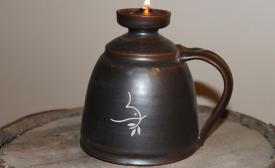
Arlyn Friesen Epp, director of Mennonite Church Canada’s Resource Centre in Winnipeg, recalls peace lamps being introduced at the 2002 MC Canada assembly in Saskatoon. Congregations were invited to purchase the lamps and pray for peace. Some churches continue to light the peace lamps today.
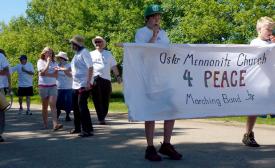
Osler Mennonite Church photo Osler (Sask.) Mennonite Church took its peace message to the community’s 2012 Canada Day parade. Described as the ‘For Peace Marching Band,’ the group played peace songs on its kazoos, earning a blue ribbon from parade organizers for ‘creativity.’

Mennonite Church Saskatchewan’s Peace and Justice Group developed a bus campaign in conjunction with MC Canada’s ‘Peace in the public square’ initiative in 2010. For two months that year, messages such as the one pictured above were seen on Saskatoon streets.

‘I think it is important for Mennonite congregations to emphasize that we are a Peace Church because we have committed our lives to Jesus . . ., not because peace is an Anabaptist distinctive that we must preserve at all cost.’ (Esther Epp-Tiessen)
“In the last 15 or 20 years, I have heard only one sermon on peace,” says Bernie Loeppky, a member of Grace Mennonite Church in Winkler, Man., and a member of the Evangelical Anabaptist Fellowship (EAF).
For discussion
1. Have you ever had an experience where you felt unjustly treated and there didn’t seem to be a way to make it right? How did you respond to those feelings of injustice? What happens in the long-term to individuals who struggle with ongoing injustice? How important is it to have past hurts recognized and validated?
Buffalo Shout, Salmon Cry contest prompts passionate responses
Clawing our way out of the morass together

This ‘freedom’ graffiti carries significance and irony for South Africans. It is emblazoned on a bridge connecting Soweto to the informal settlement of Kliptown, an area of extreme poverty.
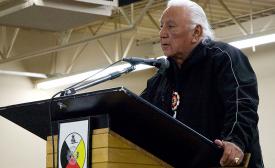
Elmer Courchene is an Anishinabe elder who carries himself with dignity but offers carefully chosen words that reflect the uncertainty within: ‘I’m 77 years old and, without a word of a lie, I’m still trying to find love.’
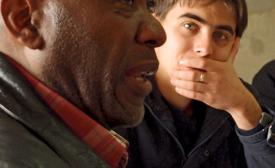
Mpho Putu, left, grew up in the midst of apartheid and took part in the 1976 Soweto Uprising as a 13-year-old student. A member of the steering committee of the Anabaptist Network in South Africa (ANiSA) since its inception, Putu sees hope and guidance in Anabaptism for the country as it recovers from apartheid’s ravages. He is pictured with Cobus van Wyngaard, an ANiSA steering committee member.
Elmer Courchene introduced himself as an Anishinabe elder whose home is Turtle Island. He carried himself with dignity, but his carefully chosen words reflected the uncertainty within: “I’m 77 years old and, without a word of a lie, I’m still trying to find love.”
For discussion
Holy contradictions
Despite gaping holes in the biblical basis for its elaborate hierarchy, and despite relatively widespread pedophilia among its priests, the Roman Catholic Church holds on to roughly twice as many official adherents—1.2 billion—as all Protestant denominations put together.
For Discussion
Profiles in education
Hindsight foresight insight
The ability to see clearly is an important sense to us as Christians and as Mennonites: our theology, The Anabaptist Vision; our music, “Be Thou My Vision”; our scripture, “Without a vision, the people perish.” Mennonite education at its best gives our church a special kind of seeing—akin to high definition or 3D. I call that hindsight, foresight and insight.
For discussion
Join the Big Hearts Club
For discussion
1. Mennonite schools had been designed to keep students separate from the “modernizing secular world” while Conrad Grebel College was deliberately set within a large public university. What are the advantages and challenges of this approach? How has the Mennonite Church changed as it has participated more closely with the world since the 1960s?
The Grebel vision at 50 years
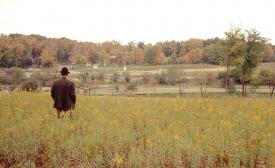
In 1963, Milton Good, the first board chair of Conrad Grebel College, looked out across Laurel Creek at the College building site.
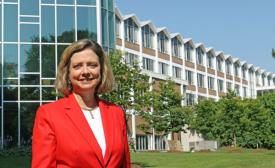
Susan Schultz Huxman stands in front of the atrium and the residential wing of Conrad Grebel University College.
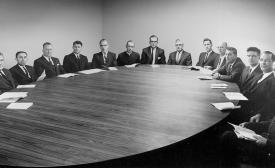
The Conrad Grebel College Board of Governors from 1964 (from left): J. Winfield Fretz, Earle Snyder, David Bergey, Mahlon Leis, Hugo Harms, Jacob Fransen, Orland Gingerich, Harvey Taves, Milton Good, Henry H. Epp, Roy G. Snyder, Douglas Millar, John Snyder, Norman High, John Sawatsky, Kenneth Bender (not in photo: Elven Shantz, Ernest J. Swalm).
An innovative experiment in higher education
By Susan Schultz Huxman
President, Conrad Grebel University College
Ministry in a very different world
For discussion
Finding new paths through the wilderness
The economy and my new pair of shoes
The other morning, after dreaming to the tune of the constant patter of rain on the tin roof of my house, I woke early to enjoy a morning stroll through the mountains of northern Guatemala. After an hour or so of watching the mystical dance of clouds caressing the valleys and peaks of the green hills, I began to notice that my right foot was soaking wet.






